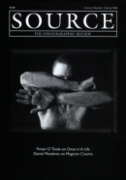Once in a Life
Review by Fintan O'Toole
Issue 7 Spring 1996
View Contents ▸
Susan Sontag, in her book On Photography, noted a study in France that found families with children twice as likely to have a camera as families with none. 'Not to take pictures of one's children, particularly when they are small', she writes, 'is a sign of parental indifference...' And she sees this not as a tribute to children and the family, but as evidence of a crisis. For her, the family photograph album stands as a sign of the breakdown of family connections, photography coming along 'to restate symbolically the imperilled continuity and vanishing extendedness of family life'. And this is part of her general critique of the medium of photography itself, her belief that photographs do not so much reproduce experience as reduce it, not so much signify life as replace it.
'Once in a Life', the photographic exhibition which opened The Ark, the new childrens' cultural centre in Dublin, was, amongst other things, a rebuke to Sontag's pessimism. It did indeed depend on the connection between photography and childhood, serving in a sense as a family album write large, making public and social the pictures of childhood that are usually private and familial. It might be regarded as a kind of memento of the children of the nation, invoking memories of Irish childhood throughout the last century, probing and testing the connectedness or lack of connection between the generations. But it suggested that photographs do not necessarily reduce experience and that they can, indeed, enhance and expand it.
The Ark has ambitions to be a cultural centre in which children are regarded as audiences and participants in their own right rather than being constructed as audiences of the future. It is based on the belief 'that children are citizens of the present with cultural entitlements'. And 'Once in a Life' was constructed so as to emphasise this very notion of 'presentness', both in the simple sense that photographs reflect a unique moment in time, and in the subtler sense that the images are also constructed by the viewer here and now rather than existing in an abstract space beyond the context in which they are viewed. Grandfather and Boy, from the Fr. Browne Collection
Grandfather and Boy, from the Fr. Browne Collection
On both levels, it worked. Simply as an exhibition of forty Irish photographs, it revealed a quality of both documentary and stylistic value that is still underrated. Some of the strongest images - of an old man and a small child in Kilkenny in 1928, of a man blowing bubbles on a street in Carrick, Co. Donegal in 1946 surrounded by delighted children, of a tiny child working at a pump in Roscommon in 1937 - were drawn from the Fr. Browne collection, and suggest that over time, as the documentary value of those pictures comes to be taken for granted, the artistic achievement of the best of them will come to be regarded as a very considerable one.
But there were also unfamiliar images by photograhers like Thomas Wynne, Alexander Robert Hogg, Mary Alice Young, William Green and Herbert Allison, from the collections of the National Library, The U.C.D. Folklore Archive, The Ulster Museum, The Ulster Folk and Transport Museum, The Northern Ireland Public Record Office that hint at a photographic heritage that is only beginning to make its way into public consciousness.
At the second level, that of the construction and critique of the images themselves, 'Once in a Life' managed the difficult task of being instructive without being patronising. The images were grouped into eight themes; holding the child, home and play, playing games, schools and institutions, work, portraits, children and animals, and 'moments', The children were invited to interrogate, not just the individual images themselves but also their relation to each other, bringing out counterpoints and contrasts both of form and asking the children to find specified elements within the images. But thoughtful arrangement within the groups also provoked reflection on the different attitudes of the photographers, the social inequalities inherent in the lives depicted, the institutional contexts in which the images were made, and the process of selection which had constructed the exhibition itself.
This latter set of questions was taken further by inviting the children to constructing their own exhibition from a given group of thirty images, by taking them through the technological alteration of a specific photographic image from the original glass-plate negative to computer enhancement and reproduction on T-shirts and posters, and by letting them take their own pictures of each other. Through this process, the children were allowed to encounter both the values of photographs and the need to question their values, to see both photographic images and childhood as social constructions rather than natural processes.
In doing this, 'Once in a Life' served at once to question and to vindicate the place of photography in culture. It created a necessary tension between the value of photographs as information and the need to constantly question the way in which that information is being constructed and transmitted. It resisted the nostalgia and sentimentality always inherent in photographs of the past and doubly so in photographs of children, by raising questions of class, gender and social control. But ultimately it provided a strong argument against Susan Sontag's belief that photography reduces experience and depends on an absence of connection. It both provided an experience in itself and suggested the ways in which connections of family, of time and of society must be created in the imagination and held in place by a continual process of choice. That process of choice is what we call culture, and on this evidence photography is beginning to take its place in ours.
Other articles by Fintan O'Toole:






